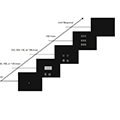Abstract
Three experiments tested whether the Stroop color-naming effect is a consequence of word recognition’s being automatic or of the color word’s capturing visual attention. In Experiment 1, a color bar was presented at fixation as the color carrier, with color and neutral words presented in locations above or below the color bar; Experiment 2 was similar, except that the color carrier could occur in one of the peripheral locations and the color word at fixation. The Stroop effect increased as display duration increased, and the Stroop dilution effect (a reduced Stroop effect when a neutral word is also present) was an approximately constant proportion of the Stroop effect at all display durations, regardless of whether the color bar or color word was at fixation. In Experiment 3, the interval between the onsets of the to-be-named color and the color word was manipulated. The Stroop effect decreased with increasing delay of the color word onset, but the absolute amount of Stroop dilution produced by the neutral word increased. This study’s results imply that an attention shift from the color carrier to the color word is an important factor modulating the size of the Stroop effect.
